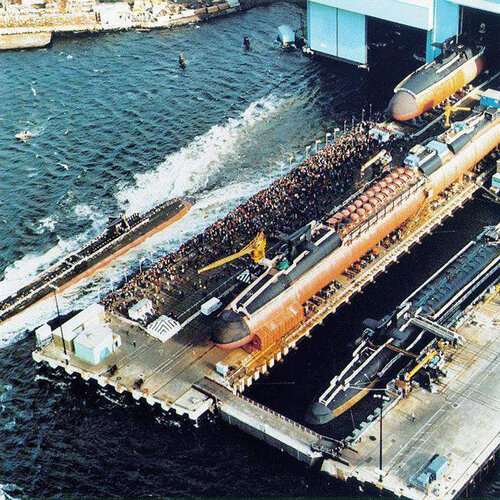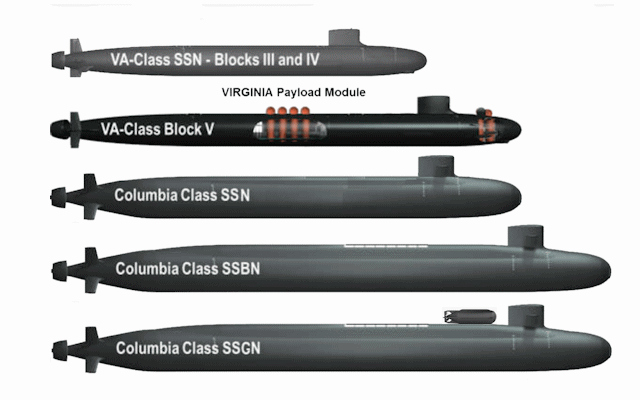Report to Congress on SSN(X) Next-Generation Attack Submarine
December 14, 2022 7:46 AM
Introduction
The Navy wants to begin procuring a new class of nuclear- powered attack submarine (SSN), called the Next- Generation Attack Submarine or SSN(X), in the mid-2030s. The SSN(X) would be the successor to the Virginia-class SSN design, which the Navy has been procuring since FY1998. The Navy’s proposed FY2023 budget requests $237.0 million in research and development funding for the SSN(X) program.
Submarines in the U.S. Navy
The U.S. Navy operates nuclear-powered ballistic missile submarines (SSBNs), nuclear-powered cruise missile and special operations forces (SOF) submarines (SSGNs), and nuclear-powered attack submarines (SSNs). The SSNs are general-purpose submarines that can perform a variety of peacetime and wartime missions.
Virginia-Class Program
As mentioned above, the Navy has been procuring Virginia-class SSNs (Figure 1) since FY1998. Since FY2011, the Navy has been procuring them at a rate of two boats per year. When procured at a rate of two boats per year, Virginia-class SSNs equipped with the Virginia Payload Module (VPM) have a current estimated procurement cost of about $3.6 billion per boat. (Most Virginia-class boats procured in FY2019 and subsequent years are to be built with the VPM, an additional mid-body section equipped with four large-diameter, vertical launch tubes.) For additional information on Navy submarine programs, see CRS Report RL32418, Navy Virginia (SSN- 774) Class Attack Submarine Procurement: Background and Issues for Congress, by Ronald O'Rourke, and CRS Report R41129, Navy Columbia (SSBN-826) Class Ballistic Missile Submarine Program: Background and Issues for Congress, by Ronald O'Rourke.
Submarine Construction Industrial Base
U.S. Navy submarines are built by General Dynamics’ Electric Boat Division (GD/EB) of Groton, CT, and Quonset Point, RI, and Huntington Ingalls Industries’ Newport News Shipbuilding (HII/NNS), of Newport News, VA. These are the only two shipyards in the country capable of building nuclear-powered ships. GD/EB builds submarines only, while HII/NNS also builds nuclear- powered aircraft carriers. The submarine construction industrial base also includes hundreds of supplier firms, as well as laboratories and research facilities, in numerous states. Much of the material procured from supplier firms for building submarines comes from sole-source suppliers.
SSN(X) Program Program Designation
In the designation SSN(X), the “X” means that the exact design of the boat has not yet been determined.
Procurement Schedule
The Navy wants to shift from procuring Virginia-class boats to procuring SSN(X)s in the mid-2030s.
Design of the SSN(X)
The Navy states that the SSN(X) will be designed to counter the growing threat posed by near peer adversary competition for undersea supremacy. It will provide greater speed, increased horizontal payload capacity, improved acoustic superiority, and higher operational availability. SSN(X) will conduct full spectrum undersea warfare and be able to coordinate with a larger contingent of off-hull vehicles, sensors, and friendly forces. It will retain and improve multi- mission... capability and sustained combat presence in denied waters.
(Budget-justification book for FY2023 Research, Development, Test, and Evaluation, Navy account, Vol. 3 [Budget Activity 5], p. 1305.)
Navy officials have stated that the Navy wants the SSN(X) to be an “apex predator.” More specifically, they have stated that the Navy wants the SSN(X) to incorporate the speed and payload the Navy’s fast and heavily armed Seawolf (SSN-21) class SSN design, the acoustic quietness and sensors of the Virginia-class design, and the operational availability and service life of the Columbia-class design.
These requirements will likely result in an SSN(X) design that is larger than the original Virginia-class design, which has a submerged displacement of about 7,800 tons, and possibly larger than the original SSN-21 design, which has a submerged displacement of 9,138 tons. Due to technological changes over the years for improved quieting and other purposes, the designs of U.S. Navy submarines with similar payloads have generally been growing in displacement from one generation to the next.
Potential Procurement Cost
A November 2022 Congressional Budget Office (CBO) report on the Navy’s FY2023 30-year shipbuilding plan states that in constant FY2022 dollars, the SSN(X)’s average unit procurement cost is estimated at $5.6 billion by the Navy and $6.2 billion to $7.2 billion by CBO. CBO’s estimate is about 11% to 29% higher than the Navy’s estimate. The Navy and CBO estimates are about 55% (Navy) and 72% to 100% (CBO) higher than the current $3.6 billion unit procurement cost of a VPM- equipped Virginia-class SSN. The CBO report states that CBO’s estimate assumes that the SSN(X) design would have a submerged displacement about 11% greater than that of the SSN-21 design.
Issues for Congress include the following:
- whether the Navy has accurately identified the SSN(X)’s required capabilities and accurately analyzed the impact that various required capabilities can have on the SSN(X)’s cost;
- the potential impact of the SSN(X) program on funding that will be available for other Navy program priorities, particularly if CBO’s estimate of the SSN(X)’s procurement cost is more accurate than the Navy’s estimate;
- whether it would be technically feasible for the SSN(X) to be powered by a reactor plant using low-enriched uranium (LEU), rather than the highly enriched uranium (HEU) used on other Navy nuclear-powered ships, and if so, what impact that would have on nuclear arms control and nonproliferation efforts and SSN(X) costs and capabilities; and
- whether each SSN(X) should be built jointly by GD/EB and HII/NNS (the approach used for building Virginia- class SSNs and, in modified form, for building Columbia-class SSBNs), or whether individual SSN(X)s should instead be completely built within a given shipyard (the separate-yard approach used for building earlier Navy SSNs and SSBNs).











